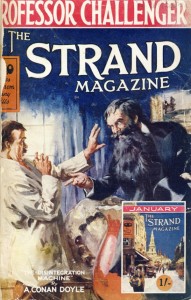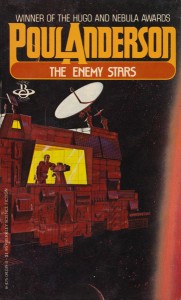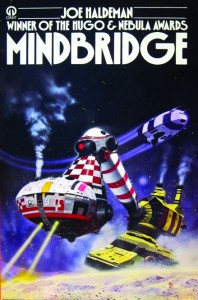Return of the Recommended Texts
I’ve had a small break after “I, Q” but it’s time to start posting again. Here are six more d-mat-related tales that I enjoyed reading while doing the research for my PhD. I can’t reiterate enough how much these stories inspired me to think about matter transmitters in new and interesting ways–new to me, anyway. The trope is so underused these days. That needs to be corrected!
 “The Disintegration Machine” (Arthur Conan Doyle, 1929)
“The Disintegration Machine” (Arthur Conan Doyle, 1929)
- Plot: Professor Challenger (spoiler alert) disintegrates the inventor of “the Nemor Disintegrator” because it could too easily be used as a weapon.
- Wonderful madness: As a practical joke, Nemor transmits the Professor without his signature beard.
- Extra goodness: This is the second time Sir Arthur used teleportation in a story. The first was only tangential to 1989’s The Mystery of Cloomber, but it was there.
“Travel by Wire!” (Arthur C Clarke, 1937)
- Plot: Less a story than an account of the early days of the “radio-transporter”.
- Neat tricks: There are many problems with this new technology. One class of accidents causes clients to lose weight, which leads led to a dieting service that people pay for. Some people arrive horrifically distorted and needs to be fixed by plastic surgeons. A celebrity sues over the slight movement of one eye.
- Extra goodness: This was the other Sir Arthur’s very first published story. Sixty years later, he and Stephen Baster published a sequel, “The Wire Continuum”, which takes the idea much more seriously (more on this in another post, probably).
 The Enemy Stars (Poul Anderson, 1958)
The Enemy Stars (Poul Anderson, 1958)
- Plot: Maintenance crews of interstellar vessels are sent by “mattercaster” from earth, which works fine until one is stuck on a ship with no way home.
- Neat trick: The stranded crew is saved by an alien race that also uses the technology, neither species knowing about the other until their technologies accidentally overlap. Parallel universes are implicated.
- Extra goodness: When the ships arrive at their destination, bigger ’casters are sent through the ones the crew use, and it’s those bigger machines that receive colonists in earnest.
- Confession: In 1996 I used the idea of maintenance crews d-matted to an uncrewed ship in “A View Before Dying”, but I swear I hadn’t read this novel beforehand. (Just goes to show: all the good ideas are taken.)
Mindbridge (Joe Haldeman, 1977)
- Plot: Explorers use the “Levant-Meyer Translation (LMT)” to explore alien worlds, but their time is limited because the journey is only temporary.
- Not a very neat trick: A mud world features, which is messy and decidedly (probably deliberately) unexciting.
- Extra goodness: If travellers eat too much from an alien world, the foreign molecules will eventually slingshot home, causing a condition called “xenasthenia” that is sometimes fatal.
“The Jaunt” (Stephen King, 1981)
- Plot: The Oates family is Jaunting to Mars. Something goes wrong (of course).
- Neat trick: Everyone who travels this way must be sedated for the journey. If you don’t, you go crazy and die. Why? Well, it’s not really the fault of the process that takes you from A to B. It’s what lies between . . .
- Extra goodness: The Jaunt was invented in 1987. I wish!
 “We are for the Dark” (Robert Silverberg, 1988)
“We are for the Dark” (Robert Silverberg, 1988)
- Plot: A priest is sent via hops through “Velde receiver/transmitter stations” to check up on the increasingly faithless flock, far out in the stars.
- Neat trick: As in Enemy Stars above, humanity has sent out relativistic ships carrying receivers that, when activated, allow interstellar colonists to follow. Now the colonists are doing the same thing and spreading deeper into space, where they have encountered legacy alien stations that take them out even further–mirroring the main character’s spiritual journey away from his faith.
- Extra goodness: If you ever wonder why Silverberg is so highly regarded, read this story, written decades after Star Trek et al practically killed matter transmitters dead. Not only did he come up with an interesting new story to tell, but he also imbued it with layers upon layers of meaning, making it one of the richest works in the oeuvre. “Do think that travelling between the stars is like stepping across the street?” he says. Of course it wouldn’t be.
- Bonus extra goodness: There are several references to South Australia, including a character who (like me, until recently) hasn’t seen snow.
More to come! I did a LOT of research. 🙂
